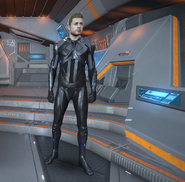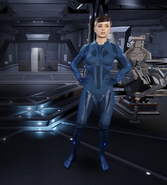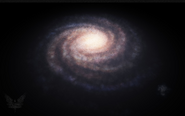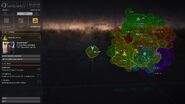m (Corrected The Bubble to Core Systems) Tag: Visual edit |
(→Gallery: added image of Earth) Tag: Visual edit |
||
| (8 intermediate revisions by 2 users not shown) | |||
| Line 9: | Line 9: | ||
== History == |
== History == |
||
| + | [[File:Elite-Dangerous-India-South-Asia.png|thumb|250px|[[Earth]]]] |
||
=== Evolution === |
=== Evolution === |
||
| − | The human species (Homo sapiens) evolved from apelike ancestor over the course of 6 million years BCE (Before Common Era). Scientific evidence shows that humans and the great apes have a common ancestor that existed 8 to 6 million years BCE. Earth's African continent is where much of human evolution occurred. 6 to 2 million years BCE |
+ | The human species (Homo sapiens) evolved from apelike ancestor over the course of 6 million years BCE (Before Common Era). Scientific evidence shows that humans and the great apes have a common ancestor that existed 8 to 6 million years BCE. Earth's African continent is where much of human evolution occurred. Fossils dating from 6 to 2 million years BCE originate only in Africa.<ref name=":0">[http://humanorigins.si.edu/education/introduction-human-evolution Introduction to Human Evolution - Smithsonian] |
</ref> |
</ref> |
||
| − | A defining human trait to walk on two legs (bipedalism) evolved 4 million years BCE. Other human characteristics like a complex brain, using tools and language developed much later. Advanced human traits such as art, cultural diversity and symbolic expression |
+ | A defining human trait to walk on two legs (bipedalism) evolved 4 million years BCE. Other human characteristics like a complex brain, using tools and capacity for language developed much later. Advanced human traits such as art, cultural diversity and symbolic expression developed during the last 100,000 years BCE.<ref name=":0" /> |
=== Agriculture === |
=== Agriculture === |
||
| − | During much of human history people lived |
+ | During much of human history, people lived hunter-gatherer lifestyles. The invention of agriculture in 12,000 BCE allowed people to live in permanent settlements which became cities and civilizations. Food could be produced to meet consumer demand so Earth's population grew from 5 million in 8,000 BCE to over 7 billion in the 21st century CE.<ref>[https://genographic.nationalgeographic.com/development-of-agriculture/ The Development of Agriculture - National Geographic] |
| − | </ref> As agriculture secured people's primary needs for food, |
+ | </ref> As agriculture secured people's primary needs for food, this allowed attention to be focussed on other things, like science, trade, technology, art and innovation. |
=== Commerce === |
=== Commerce === |
||
| − | The demand of individuals and |
+ | The demand of individuals and businesses to trade easily led to innovations in commerce and finance. In 9000 BCE people bartered goods they had in surplus for things they lacked, such as cattle, sheep, vegetables and grain. The first known currency was created by King Alyattes in the ancient kingdom of Lydia, modern-day Turkey, in 600 BCE. The first coin ever minted featured a roaring lion design. Bank notes were developed in around 1661 AD. An advantage of paper money was that it could be mass-produced without relying on rare or expensive raw materials like gold and silver; in spite of this, its value is more unstable than precious metals. The first credit card was introduced in 1946. The first decentralized digital currency, Bitcoin, was invented in 2009 and wireless payments gained popularity. The invention of money and commerce has been essential to developing trade networks, fostering cooperation and understanding between different cultures and peoples across Earth.<ref>[http://www.telegraph.co.uk/finance/businessclub/money/11174013/The-history-of-money-from-barter-to-bitcoin.html The history of money: from barter to bitcoin - Telegraph.co.uk] |
| − | </ref> Entrepreneurship and innovation lead to the |
+ | </ref> Entrepreneurship and innovation lead to the Industrial Revolution, starting in Western Europe in 1760 AD, and the Digital Revolution in 1970 AD with inventions like digital electronics. Commerce brought people and [[countries]] together through mutual cooperation, division of labour and trade. |
=== '''Great Powers & Empires''' === |
=== '''Great Powers & Empires''' === |
||
| − | Many great powers and empires |
+ | Many great powers and empires have risen and fallen throughout [[Earth]]'s history. According to the treaty of Chaumont in 1814, a "great power" is a nation or state that, through its great economic, political and military strength, is able to exert power and influence over not only its own region of the world, but beyond to others.<ref>Powell, Philip Wayne (October 16, 2008). Tree of Hate: Propaganda and Prejudices Affecting United States Relations with the Hispanic World. University of New Mexico Press; First Edition, First Printing edition. ISBN 978-0826345769. |
</ref> The most significant were:<ref>https://en.wikipedia.org/wiki/List_of_ancient_great_powers</ref> |
</ref> The most significant were:<ref>https://en.wikipedia.org/wiki/List_of_ancient_great_powers</ref> |
||
* Ancient Egypt (3150 BCE - 332 BCE) |
* Ancient Egypt (3150 BCE - 332 BCE) |
||
| Line 42: | Line 43: | ||
* Qing Dynasty (1644 CE to 1912 CE) |
* Qing Dynasty (1644 CE to 1912 CE) |
||
* Russian Empire (1721 CE – 1917 CE) |
* Russian Empire (1721 CE – 1917 CE) |
||
| + | * Empire of Japan (1868 CE - 1947 CE) |
||
| + | * American Imperialism (1800 CE - 2242 CE) |
||
=== Colonialism and Imperialism === |
=== Colonialism and Imperialism === |
||
| − | In the 16th century to the mid-20th century several European maritime powers used their technological and military advantages to establish colonies and claim vast territories in Asia, Africa, and the Americas. European culture and technology spread throughout the less developed world. During the 19th and early 20th century most of Earth's landmass was controlled by European powers.<ref>https://en.wikipedia.org/wiki/Colonialism</ref><ref>https://en.wikipedia.org/wiki/Imperialism</ref> |
+ | In the 16th century to the mid-20th century several European maritime powers used their technological and military advantages to establish colonies and claim vast territories in Asia, Africa, and the Americas. European culture and technology spread throughout the less developed world. During the 19th century and early 20th century most of Earth's landmass was controlled by European powers.<ref>https://en.wikipedia.org/wiki/Colonialism</ref><ref>https://en.wikipedia.org/wiki/Imperialism</ref> |
| − | World War I (28 July 1914 to 11 November 1918) was the first global war |
+ | World War I (28 July 1914 to 11 November 1918) was the first global war, and originated in Europe. World War II was the second global war (1939 to 1945) and had two opposing military alliances, known as the Allied and the Axis powers, comprising the majority of Earth's countries. World wars were different from previous wars, because they were fought between powers that had many colonies overseas. This meant that when two colonial powers went to war, their overseas territories went to war as well. The different ideologies and regimes from classical liberalism to national socialism, fascism and communism clashed in very destructive conflicts which killed tens of millions of people in both world wars. The remaining colonies gained independence in the mid-20th century, after World War II came to an end.<ref>https://en.wikipedia.org/wiki/World_War_I</ref><ref>https://en.wikipedia.org/wiki/World_War_II</ref> |
=== Superpowers === |
=== Superpowers === |
||
| − | A Superpower is a state with a dominant position, which is characterized by its extensive ability to exert influence or project power on a global scale. They are the preeminent powers among the great powers. After World War |
+ | A Superpower is a state with a dominant position, which is characterized by its extensive ability to exert influence or project power on a global scale. They are the preeminent powers among the great powers. After World War II, the United States of America and the Soviet Union were the only remaining superpowers.<ref>https://en.wikipedia.org/wiki/Superpower</ref> The Soviet Union's communist regime dissolved in January 1992. Afterwards, the United States was considered a hyperpower for a short time,<ref>[https://www.nytimes.com/1999/02/05/news/05iht-france.t_0.html To Paris, U.S. Looks Like a 'Hyperpower'] French Minister Hubert Védrine popularized the term in 1998</ref> because it greatly exceeded any others in its political environment along several axes (military, economic, cultural). |
| − | |||
| ⚫ | |||
== History in Elite == |
== History in Elite == |
||
[[File:Elite-Dangerous-Banner-Official-Art.png|thumb|250px|Elite Dangerous art]] |
[[File:Elite-Dangerous-Banner-Official-Art.png|thumb|250px|Elite Dangerous art]] |
||
| − | The history and lore of Elite is a continuation of real |
+ | The history and lore of Elite is a continuation of real-life modern history. Elite Dangerous takes place 1286 years in the future. In-game time moves at the same speed as real time. |
| + | === Rise of the Federation === |
||
| ⚫ | World War III (2044-2055 AD) was the worst war ever waged across planet [[Earth]]. It brought much destruction and loss of life. Eventually after |
||
| ⚫ | After the 21st century came to a close, the United States of America developed into the [[United States of the Americas]], which comprised North and South America. Eventually, all other [[countries]] on Earth joined it, and it became the [[Federation]] with the Federation Accord in 2242.<ref>[https://community.elitedangerous.com/en/galnet/uid/5597abc79657bab1445913c2 The Founding of the Federation - GalNet]</ref> The Federation consolidated all political power on Earth as the world government.<ref>https://en.wikipedia.org/wiki/World_government</ref> In the centuries thereafter the Federation expanded as a [[:Category:Galactic Superpower|galactic superpower]] that governs many [[Star Systems|star systems]]. |
||
| ⚫ | World War III (2044-2055 AD) was the worst war ever waged across planet [[Earth]]. It brought much destruction and loss of life. Eventually, after 11 years of war, the fight was gradually abandoned.<ref>[https://www.youtube.com/watch?v=-x-kaGsHvv0 Elite: Dangerous - Epic History of The Federation]</ref> The dominant power after the Third World War was the United States of the Americas. The remaining other [[countries]] joined it over the next few decades and it was renamed "The [[Federation]]."<ref>Tourist Spot 0165 beacon near Earth</ref> All people on Earth became [[Federal Citizen|Federal Citizens]]. Civilization had been severely ruptured, and the governments and military no longer had the ability to repair the damage done. The [[corporations]] of the era stepped in and began the slow rebuilding process. This gained the corporations a huge increase in dominance over Earth's political landscape. In many ways this was perhaps the birth of the ideologies that would ultimately influence the Federation. The 2070s saw the first human on [[Mars]] and the first permanent lunar base. This allowed humans far easier access to space, and soon many orbital cities were constructed around Earth. This was followed by the launch of interstellar probes, the heavy industrialization of the Moon and the first base construction on Mars.<ref name=":1">[https://www.youtube.com/watch?v=-x-kaGsHvv0 Elite: Dangerous - Epic History of The Federation]</ref> |
||
| ⚫ | The 22nd century was a time of |
||
| + | === 22nd century and beyond === |
||
[[File:Elite-Dangerous-Milky-Way-Galaxy.png|thumb|250px|Milky Way galaxy in Elite Dangerous]] |
[[File:Elite-Dangerous-Milky-Way-Galaxy.png|thumb|250px|Milky Way galaxy in Elite Dangerous]] |
||
| ⚫ | The 22nd century was a time of great change. Fossils were discovered on Mars proving that life once existed there. Human expansion slowly progressed throughout the solar system. Perhaps the biggest discovery of all time was [[hyperspace]]. The ability to travel faster than light allowed humanity to escape the confines of the solar system. It was discovered in the early 22nd century, but only since 2800s could consumer ships take advantage of it.<ref>[https://community.elitedangerous.com/en/galnet/uid/586f796c9657ba3357039d07 Galnet News - Galactic News: Hyperspace, Jan 07 3303]</ref> Hyperspace travel and spaceships became affordable for middle-class people, similarly to cars through the 20th century.<ref name=":2" /> |
||
| ⚫ | In 2210 the first signals of probes at [[Alpha Centauri]] confirmed a habitable planet existing outside our solar system. From this point on, probes continued to arrive in |
||
| + | ===<nowiki/>=== |
||
| ⚫ | The colossal requirements of modern interstellar economies can only be met by super-rich and super-powerful [[corporations]], whose innumerable companies gouge entire worlds for minerals and foods, and whose factories churn out the basic goods trillions of people need to survive. Without them and their continual drive for ever higher growth, people would starve, choke or become isolated on worlds surrounded by technology they |
||
| ⚫ | In 2210 the first signals of probes at [[Alpha Centauri]] confirmed a habitable planet existing outside our solar system. From this point on, probes continued to arrive in neighbouring star systems and soon life is discovered on Tau Ceti 3. Thus begins a new path of exploration and discovery. With the knowledge that [[Tau Ceti]] could support life, a colony ship was sent there. Before long the first colony to exist outside [[Sol]], our original solar system, was formed. With the proof that life existed away from Earth, a mass exodus began. Massive ships were constructed to establish human colonies anywhere that may support human life. The expansion of humanity rapidly moved apace, crossing the void between star systems. New colonies and ultimately cities were formed. The Federation is dominated by corporations. They control many aspects of life, politics and business within Federation space. Most aspects of life is focused on profit. Whilst [[corporations]] are not above the law, they hold a very wide remit as far as what they're permitted to do in the name of profit. |
||
| + | |||
| ⚫ | The colossal requirements of modern interstellar economies can only be met by super-rich and super-powerful [[corporations]], whose innumerable companies gouge entire worlds for minerals and foods, and whose factories churn out the basic goods that trillions of people need to survive. Without them and their continual drive for ever higher growth, people would starve, choke or become isolated on worlds surrounded by technology they could not use or maintain.<ref>[https://www.edrpg.co.uk/what-s-in-the-books Elite Dangerous Role Playing Game, Corporate Guide book]</ref> |
||
== Lore == |
== Lore == |
||
| + | [[File:ED-Surface-Port-on-Planet.png|thumb|250px|Surface Port]] |
||
| + | |||
The official [[Elite Dangerous Role Playing Game|Elite: Dangerous Role Playing Game]] has in-depth lore about the universe of Elite: Dangerous. Here's a summary: |
The official [[Elite Dangerous Role Playing Game|Elite: Dangerous Role Playing Game]] has in-depth lore about the universe of Elite: Dangerous. Here's a summary: |
||
| − | Cheap |
+ | Cheap, faster-than-light travel has enabled humanity to expand across the stars. This led to the rise of the [[Federation]], [[Empire]] and [[Alliance]]. These major [[factions]] attract [[Powers|powerful people]] who scheme to gain more power.<ref name=":2">[https://www.kickstarter.com/projects/edrpg/elite-dangerous-role-playing-game Elite Dangerous Role Playing Game - Kickstarter] |
</ref> |
</ref> |
||
| − | The middle |
+ | The middle classes of the galaxy can afford spaceships, akin to how the 20th-century middle classes could increasingly afford cars. People who own spaceships gain tremendous freedom. They're encouraged to do all kinds of jobs such as delivering goods and supplies to [[station]]s. For people at the bottom of society, however, little has changed. Space trade is seldom hampered by politics. The planet-spanning [[Mega Corporation|mega corporations]] employ entire nations and rule unchecked over vast sections of the [[galaxy]]. There's a laissez-faire attitude towards weapon ownership and people are inclined to shoot first, ask later. The general lawlessness of space, navigational hazards and fierce creatures on [[planets]] make it a dangerous place.<ref name=":2" /> |
== Human Space == |
== Human Space == |
||
| Line 84: | Line 92: | ||
[[File:Elite Dangerous Human City Concept Art.png|thumb|250px|Human Megalopolis City Concept Art]] |
[[File:Elite Dangerous Human City Concept Art.png|thumb|250px|Human Megalopolis City Concept Art]] |
||
| − | As |
+ | As has been recorded throughout history, humanity is not prone to agreement over ethical, political, religious, and economic views. It remains this way today in the 34th century, with the human-colonized space held by numerous groups with various ideals and conflicts of interest. |
| − | There are three major [[factions]] known as galactic superpowers and several [[Powers]] in human-colonized space. The [[Federation]] is based in [[Sol]] and is a representative-electing democracy. The [[Empire]] is based from the system of [[Achenar]] and is a hereditary monarchy. The [[Alliance]] is based from the system of [[Alioth]] and is a confederation of independent systems working cooperatively. Powers are |
+ | There are three major [[factions]], known as galactic superpowers, and several lesser [[Powers]] in human-colonized space. The [[Federation]] is based in [[Sol]] and is a representative-electing democracy. The [[Empire]] is based from the system of [[Achenar]] and is a hereditary monarchy. The [[Alliance]] is based from the system of [[Alioth]] and is a confederation of independent systems working cooperatively. Powers are influential individuals or organizations who strive to control human-inhabited space for their own agendas in [[Powerplay]]. Each Power can control a vast number of systems that are aligned to both major and minor factions. In addition to the three galactic superpowers and the powers, there are also many minor factions. The faction with the highest influence within the system will usually be the controlling faction of that system. System control falls on the faction that owns the controlling station. The government of a system is ruled by a controlling faction, and if that faction is classed as Anarchy, then no formal laws will apply in the system. |
| − | == |
+ | == Videos == |
| + | <gallery hideaddbutton="true"> |
||
| ⚫ | |||
| + | File:Lakon's ASP Explorer Advert |
||
| + | File:Pale_Blue_Dot |
||
| + | </gallery> |
||
== Gallery == |
== Gallery == |
||
<gallery hideaddbutton="true"> |
<gallery hideaddbutton="true"> |
||
| − | Human-Race-Male.png|Human Male |
+ | File:Human-Race-Male.png|Human Male |
| − | Human-Race-Female.png|Human Female |
+ | File:Human-Race-Female.png|Human Female |
| − | Elite Dangerous Human City Concept Art.png|Human Megalopolis City Concept Art |
+ | File:Elite Dangerous Human City Concept Art.png|Human Megalopolis City Concept Art |
| − | Elite-Dangerous- |
+ | File:Elite-Dangerous-India-South-Asia.png|Earth |
| + | File:Elite-Dangerous-Milky-Way-Galaxy.png|Milky Way galaxy in Elite Dangerous |
||
| − | Elite_Dangerous_Powerplay_Bubble.jpg|The Core Systems is where powers compete for influence, resources, territory and control. |
+ | File:Elite_Dangerous_Powerplay_Bubble.jpg|The Core Systems is where powers compete for influence, resources, territory and control. |
| − | Elite-Dangerous-Banner-Official-Art.png|Elite Dangerous banner art |
+ | File:Elite-Dangerous-Banner-Official-Art.png|Elite Dangerous banner art |
</gallery> |
</gallery> |
||
| + | |||
| + | == References == |
||
| ⚫ | |||
{{SpeciesNavbox}} |
{{SpeciesNavbox}} |
||
Revision as of 23:58, 7 December 2019
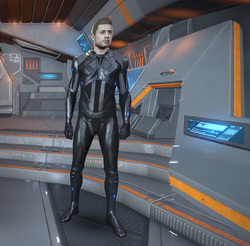
Human Male
Humans are a sentient species of bipedal mammals, native to planet Earth and the Sol system. Since the discovery of faster than light hyperspace travel, humans have rapidly expanded beyond Sol. They primarily populate a region of the galaxy known as the Core Systems and have colonized all sorts of planets from airless to atmospheric worlds. Many stations were constructed so that humans can live, produce and trade goods and services in space. Humans engage many different activities such as trading and exploration. They're a Type II civilization according to the Kardashev scale.
Biology
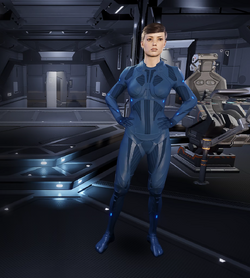
Human Female
Humans have a robust physiology. They are bipedal mammals and generally strong, fast and agile. They reach physical maturity at around 18 years old. Then they enter the workforce or continue their education for a profession. The average human lifespan is naturally about 79 years, but advanced biotechnology and cybernetics have substantially increased longevity. Progenitor Cells are used to restore damage in older human cells and greatly extend human life expectancy.
Since the late 20th century there's been increased mixing of different human ethnicities. This resulted in certain recessive physical traits becoming rare such as blue and green eyes as well as blonde and red hair.
The Empire supports and uses human cloning extensively. Other factions find it abhorrent and have banned it within their own jurisdictions. The Federation prefers mechanical artificial intelligence.
History
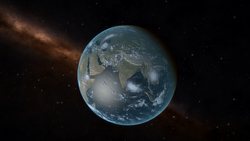
Evolution
The human species (Homo sapiens) evolved from apelike ancestor over the course of 6 million years BCE (Before Common Era). Scientific evidence shows that humans and the great apes have a common ancestor that existed 8 to 6 million years BCE. Earth's African continent is where much of human evolution occurred. Fossils dating from 6 to 2 million years BCE originate only in Africa.[1]
A defining human trait to walk on two legs (bipedalism) evolved 4 million years BCE. Other human characteristics like a complex brain, using tools and capacity for language developed much later. Advanced human traits such as art, cultural diversity and symbolic expression developed during the last 100,000 years BCE.[1]
Agriculture
During much of human history, people lived hunter-gatherer lifestyles. The invention of agriculture in 12,000 BCE allowed people to live in permanent settlements which became cities and civilizations. Food could be produced to meet consumer demand so Earth's population grew from 5 million in 8,000 BCE to over 7 billion in the 21st century CE.[2] As agriculture secured people's primary needs for food, this allowed attention to be focussed on other things, like science, trade, technology, art and innovation.
Commerce
The demand of individuals and businesses to trade easily led to innovations in commerce and finance. In 9000 BCE people bartered goods they had in surplus for things they lacked, such as cattle, sheep, vegetables and grain. The first known currency was created by King Alyattes in the ancient kingdom of Lydia, modern-day Turkey, in 600 BCE. The first coin ever minted featured a roaring lion design. Bank notes were developed in around 1661 AD. An advantage of paper money was that it could be mass-produced without relying on rare or expensive raw materials like gold and silver; in spite of this, its value is more unstable than precious metals. The first credit card was introduced in 1946. The first decentralized digital currency, Bitcoin, was invented in 2009 and wireless payments gained popularity. The invention of money and commerce has been essential to developing trade networks, fostering cooperation and understanding between different cultures and peoples across Earth.[3] Entrepreneurship and innovation lead to the Industrial Revolution, starting in Western Europe in 1760 AD, and the Digital Revolution in 1970 AD with inventions like digital electronics. Commerce brought people and countries together through mutual cooperation, division of labour and trade.
Great Powers & Empires
Many great powers and empires have risen and fallen throughout Earth's history. According to the treaty of Chaumont in 1814, a "great power" is a nation or state that, through its great economic, political and military strength, is able to exert power and influence over not only its own region of the world, but beyond to others.[4] The most significant were:[5]
- Ancient Egypt (3150 BCE - 332 BCE)
- Babylonia (1895 BCE – 619 BCE)
- Kingdom of Kush (785 BCE - CE 350)
- Achaemenid Empire (550 BCE – 330 BCE)
- Roman Empire (509 BCE - 1453 CE)
- Macedonian Empire ( 359 BCE - 323 BCE)
- Maurya Empire (322 BCE - 180 BCE)
- Mongol Empire (1206 CE - 1368 CE)
- Ottoman Empire (1566 CE - 1789 CE)
- Spanish Empire (1492 CE - 1810 CE, it was the first global empire in world history)[6][7]
- Mughal Empire (1526 CE - 1857 CE)
- British Empire (1583 CE - 1913 CE)
- French Colonial Empire (1534 CE –1939 CE)
- Qing Dynasty (1644 CE to 1912 CE)
- Russian Empire (1721 CE – 1917 CE)
- Empire of Japan (1868 CE - 1947 CE)
- American Imperialism (1800 CE - 2242 CE)
Colonialism and Imperialism
In the 16th century to the mid-20th century several European maritime powers used their technological and military advantages to establish colonies and claim vast territories in Asia, Africa, and the Americas. European culture and technology spread throughout the less developed world. During the 19th century and early 20th century most of Earth's landmass was controlled by European powers.[8][9]
World War I (28 July 1914 to 11 November 1918) was the first global war, and originated in Europe. World War II was the second global war (1939 to 1945) and had two opposing military alliances, known as the Allied and the Axis powers, comprising the majority of Earth's countries. World wars were different from previous wars, because they were fought between powers that had many colonies overseas. This meant that when two colonial powers went to war, their overseas territories went to war as well. The different ideologies and regimes from classical liberalism to national socialism, fascism and communism clashed in very destructive conflicts which killed tens of millions of people in both world wars. The remaining colonies gained independence in the mid-20th century, after World War II came to an end.[10][11]
Superpowers
A Superpower is a state with a dominant position, which is characterized by its extensive ability to exert influence or project power on a global scale. They are the preeminent powers among the great powers. After World War II, the United States of America and the Soviet Union were the only remaining superpowers.[12] The Soviet Union's communist regime dissolved in January 1992. Afterwards, the United States was considered a hyperpower for a short time,[13] because it greatly exceeded any others in its political environment along several axes (military, economic, cultural).
History in Elite

Elite Dangerous art
The history and lore of Elite is a continuation of real-life modern history. Elite Dangerous takes place 1286 years in the future. In-game time moves at the same speed as real time.
Rise of the Federation
After the 21st century came to a close, the United States of America developed into the United States of the Americas, which comprised North and South America. Eventually, all other countries on Earth joined it, and it became the Federation with the Federation Accord in 2242.[14] The Federation consolidated all political power on Earth as the world government.[15] In the centuries thereafter the Federation expanded as a galactic superpower that governs many star systems.
World War III (2044-2055 AD) was the worst war ever waged across planet Earth. It brought much destruction and loss of life. Eventually, after 11 years of war, the fight was gradually abandoned.[16] The dominant power after the Third World War was the United States of the Americas. The remaining other countries joined it over the next few decades and it was renamed "The Federation."[17] All people on Earth became Federal Citizens. Civilization had been severely ruptured, and the governments and military no longer had the ability to repair the damage done. The corporations of the era stepped in and began the slow rebuilding process. This gained the corporations a huge increase in dominance over Earth's political landscape. In many ways this was perhaps the birth of the ideologies that would ultimately influence the Federation. The 2070s saw the first human on Mars and the first permanent lunar base. This allowed humans far easier access to space, and soon many orbital cities were constructed around Earth. This was followed by the launch of interstellar probes, the heavy industrialization of the Moon and the first base construction on Mars.[18]
22nd century and beyond
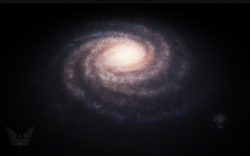
Milky Way galaxy in Elite Dangerous
The 22nd century was a time of great change. Fossils were discovered on Mars proving that life once existed there. Human expansion slowly progressed throughout the solar system. Perhaps the biggest discovery of all time was hyperspace. The ability to travel faster than light allowed humanity to escape the confines of the solar system. It was discovered in the early 22nd century, but only since 2800s could consumer ships take advantage of it.[19] Hyperspace travel and spaceships became affordable for middle-class people, similarly to cars through the 20th century.[20]
In 2210 the first signals of probes at Alpha Centauri confirmed a habitable planet existing outside our solar system. From this point on, probes continued to arrive in neighbouring star systems and soon life is discovered on Tau Ceti 3. Thus begins a new path of exploration and discovery. With the knowledge that Tau Ceti could support life, a colony ship was sent there. Before long the first colony to exist outside Sol, our original solar system, was formed. With the proof that life existed away from Earth, a mass exodus began. Massive ships were constructed to establish human colonies anywhere that may support human life. The expansion of humanity rapidly moved apace, crossing the void between star systems. New colonies and ultimately cities were formed. The Federation is dominated by corporations. They control many aspects of life, politics and business within Federation space. Most aspects of life is focused on profit. Whilst corporations are not above the law, they hold a very wide remit as far as what they're permitted to do in the name of profit.
The colossal requirements of modern interstellar economies can only be met by super-rich and super-powerful corporations, whose innumerable companies gouge entire worlds for minerals and foods, and whose factories churn out the basic goods that trillions of people need to survive. Without them and their continual drive for ever higher growth, people would starve, choke or become isolated on worlds surrounded by technology they could not use or maintain.[21]
Lore

Surface Port
The official Elite: Dangerous Role Playing Game has in-depth lore about the universe of Elite: Dangerous. Here's a summary:
Cheap, faster-than-light travel has enabled humanity to expand across the stars. This led to the rise of the Federation, Empire and Alliance. These major factions attract powerful people who scheme to gain more power.[20]
The middle classes of the galaxy can afford spaceships, akin to how the 20th-century middle classes could increasingly afford cars. People who own spaceships gain tremendous freedom. They're encouraged to do all kinds of jobs such as delivering goods and supplies to stations. For people at the bottom of society, however, little has changed. Space trade is seldom hampered by politics. The planet-spanning mega corporations employ entire nations and rule unchecked over vast sections of the galaxy. There's a laissez-faire attitude towards weapon ownership and people are inclined to shoot first, ask later. The general lawlessness of space, navigational hazards and fierce creatures on planets make it a dangerous place.[20]
Human Space
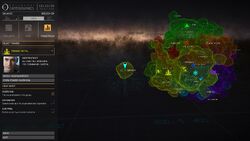
The bubble is where powers compete for influence, resources, territory and control.
Humans primarily reside in a colonized region colloquially known as the Core Systems, which contains about 19,000 star systems. They originated from the single-star system Sol and the terrestrial planet Earth in the Orion-Cygnus Arm of the Milky Way. Humans have created more bubbles in deep space such as the Colonia Region, Pleiades Nebula and California Nebula.
Society
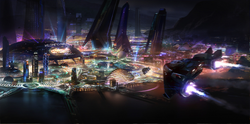
Human Megalopolis City Concept Art
As has been recorded throughout history, humanity is not prone to agreement over ethical, political, religious, and economic views. It remains this way today in the 34th century, with the human-colonized space held by numerous groups with various ideals and conflicts of interest.
There are three major factions, known as galactic superpowers, and several lesser Powers in human-colonized space. The Federation is based in Sol and is a representative-electing democracy. The Empire is based from the system of Achenar and is a hereditary monarchy. The Alliance is based from the system of Alioth and is a confederation of independent systems working cooperatively. Powers are influential individuals or organizations who strive to control human-inhabited space for their own agendas in Powerplay. Each Power can control a vast number of systems that are aligned to both major and minor factions. In addition to the three galactic superpowers and the powers, there are also many minor factions. The faction with the highest influence within the system will usually be the controlling faction of that system. System control falls on the faction that owns the controlling station. The government of a system is ruled by a controlling faction, and if that faction is classed as Anarchy, then no formal laws will apply in the system.
Videos
Gallery
References
- ↑ 1.0 1.1 Introduction to Human Evolution - Smithsonian
- ↑ The Development of Agriculture - National Geographic
- ↑ The history of money: from barter to bitcoin - Telegraph.co.uk
- ↑ Powell, Philip Wayne (October 16, 2008). Tree of Hate: Propaganda and Prejudices Affecting United States Relations with the Hispanic World. University of New Mexico Press; First Edition, First Printing edition. ISBN 978-0826345769.
- ↑ https://en.wikipedia.org/wiki/List_of_ancient_great_powers
- ↑ Thomas, Hugh (August 11, 2015). World Without End: Spain, Philip II, and the First Global Empire. Random House. pp. 496 pages. ISBN 0812998111.
- ↑ https://en.wikipedia.org/wiki/Spanish_Empire
- ↑ https://en.wikipedia.org/wiki/Colonialism
- ↑ https://en.wikipedia.org/wiki/Imperialism
- ↑ https://en.wikipedia.org/wiki/World_War_I
- ↑ https://en.wikipedia.org/wiki/World_War_II
- ↑ https://en.wikipedia.org/wiki/Superpower
- ↑ To Paris, U.S. Looks Like a 'Hyperpower' French Minister Hubert Védrine popularized the term in 1998
- ↑ The Founding of the Federation - GalNet
- ↑ https://en.wikipedia.org/wiki/World_government
- ↑ Elite: Dangerous - Epic History of The Federation
- ↑ Tourist Spot 0165 beacon near Earth
- ↑ Elite: Dangerous - Epic History of The Federation
- ↑ Galnet News - Galactic News: Hyperspace, Jan 07 3303
- ↑ 20.0 20.1 20.2 Elite Dangerous Role Playing Game - Kickstarter
- ↑ Elite Dangerous Role Playing Game, Corporate Guide book



